We’re down to the last few days of the year 2017 and all of the news outlets are doing special reviews of the ‘Top Stories’ that they covered during the past year. With this in mind I’ve decided to use my final post of the year to review some of the stories I’ve written about in 2017.
First of all let’s look at some of the numbers. Over the past 52 weeks I’ve now published 102 posts so it hasn’t quite been two posts a week. Of those posts 88 have dealt with topics in one of the many fields of science while 13 have been reviews of science fiction novels or movies. (Looking at these statistics I realize I need to do some more SF posts.)
Starting with the science we’ll begin by looking at some the events that took place in man’s continuing exploration of space. A lot happened both with robotic probes throughout the Solar System as well as preparing for future manned mission beyond low Earth orbit. In my opinion however the big story in space has bee the continued success of Space X corporation. (posts of 8Mar, 1Apl, 17May, 7Jun and 14Oct)
Space X, the Hawthorn California based commercial space launch company, succeeded in launching 18 of their Falcon 9 rockets in 2017 placing a variety of satellites into orbit including two resupply mission to the International Space Station (ISS).
In addition to launching 18 of their rockets Space X also able to land 16 of the rockets. (The two that were not recovered were not failures but rather missions requiring so much fuel that a recovery was not possible.) Indeed one of the Falcon 9 rockets that flew this year had already flown in 2016 and represented the first reuse and re-recovery of the Falcon 9.
With these successes Space X has proven beyond doubt its ability to reliably reuse the Falcon 9 and hopefully this will soon lead to a considerable reduction in the cost of getting into space. The image below shows the last Space X launch of 2017, one from Vandenberg Air Force Base and which gave the southern half of California a spectacular show.
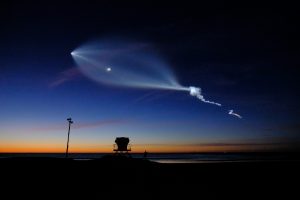
On the interplanetary exploration side of space the biggest news came from the arrival of the Juno spacecraft at Jupiter (19Jul) along with the Cassini Spacecraft’s ending its mission to Saturn with a final plunge into the atmosphere of the planet itself (15Apl, 13Sept and 14Oct). Juno has already given us the closest views ever of the biggest planet in our Solar System and has allowed scientists to study phenomenon like the great red spot in greater detail. The image below is the Great Red Spot from the Juno spacecraft.

The Cassini spacecraft had already been orbiting Saturn for more than a decade sending back breathtaking images of the Solar Systems most beautiful planet (My opinion) and its mission was coming to an end due to lack of fuel. Because the data sent back by Cassini had indicated the possibility that two of Saturn’s moons, Titan and Enceladus might harbour life it was decided to send the probe to burn up in the giant planet’s atmosphere rather than risk contaminating those moons. The image below is one of the last from Cassini.
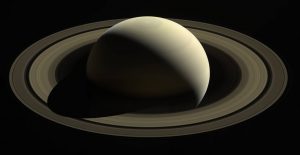
For manned space flight the year 2017 was more a waiting year as the ISS continued to be manned by Russian spacecraft but America is still hoping Space X and Boeing will begin test flights of their new manned capsules in 2018.
In the political / budget front President Trump ordered NASA to plan on a return to the Moon but there was no mention of money so no bucks, no Buck Rogers (16Dec).
In the science of Paleontology this has been a year of new discoveries along with the resolution of some long standing mysteries. New dinosaur species included the Patagotitan (16Aug), the Kayentapus (known only from its footprints) and the Sinosauropterys (both 28Oct). See images below.
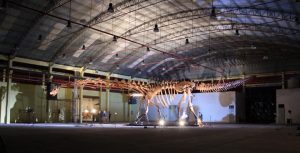
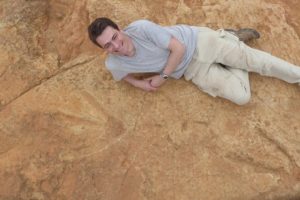

For those of us who love Trilobites, and who doesn’t, we had the most detailed description ever of the digestive system of a trilobite (29Nov). There was also a paper examining the earliest known eye that was found on a fossil trilobite (9Dec). The image below is the fossil trilobite with the earliest known eyes.
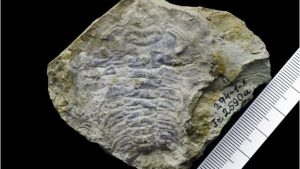
To me however the biggest news in paleontology came from a paper examining the anatomy of the ancient extinct creatures called hyoliths, small conic shaped fossils whose taxonomic place among living things had been a mystery for almost 200 years (15Jan). After studying and dissecting, yes they can dissect fossils, the best specimens of hyoliths it was found that hyoliths belonged in the same group of animals that contained the brachiopods. The image below shows an artist’s representation of a hyolith.
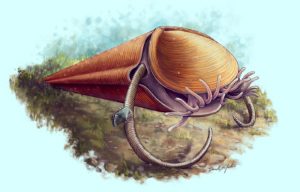
Now I’m a physicist by training so in the past year there were a lot of posts about new developments in that field. The detection of gravity waves at the Laser Interferometer Gravitywave Observatory (LIGO) probably being the most noteworthy (14Jan, 7Oct and 22Oct). In fact the observation of gravity waves won the Nobel Prize for the chief scientists at LIGO Rainer Weiss of the Massachusetts Institute of Technology (MIT) along with Kip Thorne and Barry Barish of the California Institute of Technology (Caltech).
Now the first two observations of gravity waves both came from the merger of two black holes and as you may guess aside from the gravity waves there was little else to see. The third detection on August 17th however was caused by the merger of two neutron stars resulting in an explosion so huge that it produced enough radiation to be picked up by a Gamma Ray satellite along with optical and radio telescopes. The fact that we can now integrate gravity wave observations with the observations of other astronomically instruments opens up entirely new ways of studying the Universe.
I also wrote two posts about new experiments to study the sub-atomic particles called neutrinos, the ghost particle of the atom. In particular I wrote about the design and construction of the Deep Underground Neutrino Experiment (DUNE) (30Jul and 2Dec). Now the DUNE experiment will use the Tevatron particle accelerator at Fermi-Lab to produce large streams of neutrinos that will travel beneath the Earth to a huge neutrino detector in an old gold mine outside of Lead, South Dakota. (Neutrinos interact so rarely that hardly any will be absorbed). The way the neutrinos change during the 2000km flight will tell us a great deal about this most mysterious of elementary particles. The image below shows the setup of the DUNE experiment.

Oh, and before I forget there was the post about my trip down to Sweetwater Tennessee to view the ‘Great American Eclipse of 2017’ (24Aug). It really was an awesome sight that I’ll never forget. The Image below is one of my pictures of the eclipse.
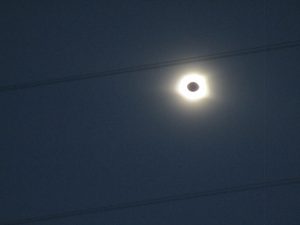
Now as I said earlier most of my posts have dealt with science but during the past twelve months I did get to review three SF movies and six novels, I even spend four posts describing what Science Fiction is in my opinion.
The three movies I reviewed were: Guardians of the Galaxy vol.2 (20May), Blade Runner 2049 (25Oct) and Thor, Ragnarok (15Nov). All of them were interesting but all of them had their faults as well. To my mind a really good SF movie is that rarest of gems that only comes around once a decade or so. Oh well, I guess maybe I’m just asking for too much.
The same is pretty much true of the six novels I reviewed. The novels were: Dark Secret by Edward M. Lerner (18Jan), New Moon by Ian McDonald (1Mar), Saturn Run by John Sandford and Ctein (12Apl), Death Wave by Ben Bova (31May), the Three Body Problem by Cixin Liu (30Aug) and Galactic Satori Chronicles Book 1: Earth by Nick Braker and Paul E. Hicks (27Sept). Each of these novels would appeal to some but the one I found most interesting and best written was The Three Body Problem by Cixin Liu. The image below shows the cover of the Three Body Problem.

Well this has been quite a long post but then it’s been a long year and a lot happened. I’m sure that next year will be just as interesting; I hope you’ll stop by on occasion to check out ‘Science and Science Fiction’.
